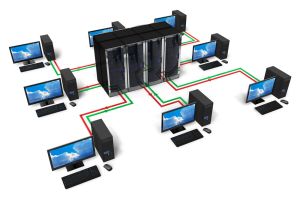Public Cloud Concerns: Myth vs. Reality
 Despite the increasing popularity and adoption of cloud services, many misperceptions still abound about their potential disadvantages. Companies considering a cloud service purchase should carefully sort through both the hype and the myths about cloud computing before making a purchasing decision.
Despite the increasing popularity and adoption of cloud services, many misperceptions still abound about their potential disadvantages. Companies considering a cloud service purchase should carefully sort through both the hype and the myths about cloud computing before making a purchasing decision.
Cloud misperceptions vary, but three primary myths have emerged that might cause IT decision makers to stop and reconsider their cloud purchase plans. However, the reality behind these myths should give buyers reassurance when it comes time to make a cloud decision.
The Data Center Death Knell Myth
With data and functionality increasingly moving to cloud services, IT employees may be concerned about being replaced by the very technologies they choose to deploy.
While this isn’t a completely unfounded concern, the reality is that cloud services are largely being adopted by younger and smaller companies that don’t already have in-house IT departments. The ability of the cloud to provide IT services that such companies would otherwise have to build from scratch is one of its primary advantages.
For companies that already have an established IT team, cloud services aren’t likely to steal away jobs anytime soon. Companies may move some of their data and processes, particularly storage, to the cloud, but most companies will continue to house critical data on private networks in a hybrid approach. In-house IT will continue to be needed to support private network operations.
The Security Myth
One of the most common and persistent misperceptions about the cloud is that it opens up companies to a variety of new security risks. The thought of having data leave the safety of the corporate security fortress and travel via potentially unprotected connections to a public cloud creates concern over attacks on a company’s critical data.
In reality, because of their singular focus on providing data services, cloud providers often have some of the best security experts on staff who focus entirely on predicting security vulnerabilities and protecting against attacks on client data.
The Data Black Hole Myth
Some companies worry that once they allow their data to transfer to a cloud service, they will lose control over it or have difficulty moving it or getting it back. This myth likely circulates because in the past, it had some truth to it. Making a cloud transition sometimes meant data was locked in with the chosen provider.
But trends surrounding this cloud concern are changing. Some of the larger cloud providers offer tools that make it easier to control and move data when the company chooses. Amazon’s Snowball appliance allows customers to easily migrate data, and Velostrata introduced an appliance that eases the migration of data to and from the public cloud.
Making an Informed Cloud Purchase
Cloud services provide many benefits to companies that want to improve their operations and increase efficiencies. IT decision makers have a responsibility to choose a cloud service that protects the company’s data assets and provides the right services for its users.
All technologies have pros and cons. Deciphering myth from reality surrounding security, data availability, and future IT employment can help decision makers make the right cloud choice.
Three Critical Infrastructure Elements for Network Uptime
 In today’s fast-paced world, where business is increasingly conducted electronically, infrastructure reliability and network up-time are crucial. Infrastructure weaknesses can lead to network downtime, and outages can prove costly for businesses.
In today’s fast-paced world, where business is increasingly conducted electronically, infrastructure reliability and network up-time are crucial. Infrastructure weaknesses can lead to network downtime, and outages can prove costly for businesses.
Network uptime can be affected by three primary factors. Focusing on adding redundancy to these three elements can help ensure network reliability and decrease the likelihood of an outage.
Overheating
Servers, like any piece of equipment, have the potential to overheat if proper steps are not taken to control their temperature. Servers typically run uninterrupted, unlike desktop PCs that are powered down, or go into idle mode throughout the day. Servers also are often housed in small rooms, and in close quarters with other network equipment. These server rooms can quickly warm to levels that can jeopardize equipment.
Whether a business is housing its own equipment, or outsourcing network and server functions to a third party or cloud provider, it is critical to ensure that network infrastructure is properly cooled. At least two cooling methods should be employed to ensure there is a backup in case one cooling method fails. Possible cooling solutions include rooftop air conditioning units, external condensers, and computer room air conditioning units.
Power Failures
Sometimes the most obvious point of weakness is the most overlooked. Infrastructure equipment requires power to function, and reliable data center power with a backup power solution for redundancy is critical.
An A+B power feed, which creates two independent channels from the public power source to the infrastructure equipment, should be at the top of the requirement list for data center power. This eliminates potential single points of failure when power channels are shared at any point.
Some of the power options that can be included in each feed are uninterruptible power supply, utility power, back-up generator, maintenance bypass panel, internal server power, mains distribution panel, and an automatic transfer switch. Each power feed should have at least one of these options, and should be able to handle the entire server load at peak usage independently to create redundancy.
Network Connections
The equipment used to connect infrastructure to the Internet is another potential point of weakness. Routers and switches wear out relatively quickly, and should be properly maintained and replaced in a timely manner. Integrating backup connections to create redundancy can help prevent network downtime. In addition, connections from the data center to the external Internet network are crucial for network uptime. Peering arrangements with multiple connections create redundancy and reliability, and can optimize performance.
Another important key to making sure potential network failure is mitigated is to choose network and infrastructure providers that are committed to reducing or eliminating single points of failure by adding backups and redundancies. Network downtime is costly and unacceptable, but there are simple ways to build in redundancy. Cutting corners on infrastructure reliability leads to network downtime and service interruptions that can ultimately cost more than building redundancy in from outset.
